After being mum on bike-sharing for about 18 months, the City of Portland Bureau of Transportation has now taken the idea back off the shelf.
At a meeting of the City’s Bicycle Advisory Committee last night, PBOT shared plans for a bike-sharing system that would blanket the Central City with 74 kiosks and 750 bikes.
The plan came up during a discussion of which projects the City of Portland will look to fund with their allocation — expected to be anywhere from 3 to 5 million — from about $18 million in federal Regional Flexible Funds (RFF) that Metro will hand out specifically to “Active Transportation” projects (I’ll share more about the other projects in a separate post).
According to Steve Hoyt-McBeth, Transportion Options Division staffer who has been managing the bike-sharing project for PBOT, the 750 bikes would serve the completed Portland Streetcar Central Loop — which encompasses Portland’s Central Business District, PSU, South Waterfront, the Central Eastside, Lloyd, Rose Quarter, Pearl/Old Town, Alphabet, and West End districts.
“The Mayor’s office has been clear all along that bike-sharing in Portland must be a public/private partnership… that’s why our plan is predicated on bringing private funding to the table.”
— Steve Hoyt-McBeth, PBOT
The Central City Bike Share plan would cost about $4 million to get up and running and $1 million annually to operate. The annual operations costs would be borne entirely from user fees (the system would have a nominal annual membership cost) and sponsorship from private companies and organizations. Essentially, once the start-up costs are paid for, the system would be financially self-sustaining.
Hoyt-McBeth says he is fully aware that without private investment the plan is a “non-starter.” “The Mayor’s office has been clear all along that bike-sharing in Portland must be a public/private partnership… that’s why our plan is predicated on bringing private funding to the table.” Hoyt-McBeth and his team are already in discussions with several partners interested in making the Central City Bike Share system a reality (Minneapolis, Denver, and Montreal have all raised over $1 million in private funding in their first year).
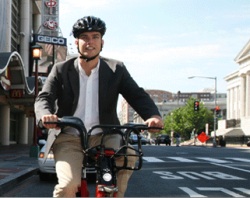
(Photo: Capital Bikeshare)
The City of Portland has regulations about how advertising can appear in the public right of way. This makes giving return on investment to private sponsors a bit more challenging; but Hoyt-McBeth feels they’ve got room to work within the rules and still give investors some bang for their buck.
The system itself would also show a quick return in terms of impact on our transportation system, Hoyt-McBeth says. He offers a very conservative estimate of 100,000 new bicycle trips in the first year of operation and 500,000 trips in the first two years. “I think that’s a pretty impressive leverage of a federal grant.”
A project description developed by PBOT, says that, once active, the proposed bike-sharing system “will result in a fully functional, complete active transportation asset that has the potential to significantly reduce single occupancy motor vehicle trips and increase the number of bicycle trips.”
In making the case for the Central City Bike Share project, PBOT points out that this area is the city’s most dense and contains 100,000 jobs and about 35,000 to 50,000 residents. In addition, 2009 Census data shows that 40% of the households in the are earn $30,000 or less per year (equity to underserved populations is a key criteria for the Metro RFF money).
Also pushing hard for this project is the Bicycle Transportation Alliance. BTA Executive Director Rob Sadowsky, currently in Washington DC for a meeting with national advocacy leaders, emailed this morning to say they feel, “bike sharing is a cost effective way to increase mode share and can work very well in Portland.” The BTA has been at the table for stakeholder meetings where interest has been shown in the project from representatives of Portland Streetcar Inc, the Portland Sustainability Institute, and the Mayor’s Office.
Keep in mind, this isn’t the only project PBOT is considering for funding with their flexible fund money. Other projects in the running include a portion of the Sullivan’s Gulch Trail, a host of bikeway improvements for East Portland, and others.
Since Transportation Commissioner (now Mayor) Sam Adams first pushed for bike-sharing in Portland nearly four years ago, several other U.S. cities have proven that such systems work. Minneapolis, Denver, and Washington D.C. have all enjoyed successful roll-outs and now — with what Hoyt-McBeth refers to as a “perfect” funding opportunity to start it up — it seems as though Portland is once again bullish on the idea.
Back in May of 2010, the Chief of Staff for Mayor Adams Tom Miller (who’s been named Director of PBOT) made it clear that Portland was waiting for the right business model and a clear U.S. success before moving forward. Both of those conditions have now been met.
We’ll keep you posted on the status of the RFF funding. Without it, Hoyt-McBeth says they’ll have to, “go back to the drawing board.”
— Learn more about Portland’s efforts to develop a bike-sharing system in our six-part series written for BikePortland by incoming PBOT Director Tom Miller. Also, browse our bike-sharing archives.

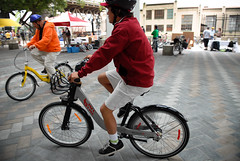
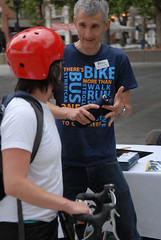


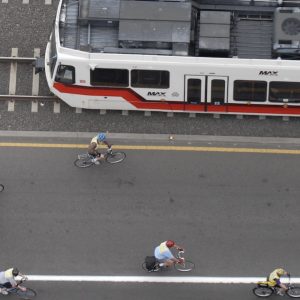
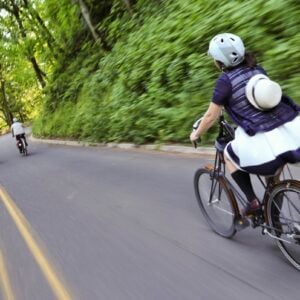
Thanks for reading.
BikePortland has served this community with independent community journalism since 2005. We rely on subscriptions from readers like you to survive. Your financial support is vital in keeping this valuable resource alive and well.
Please subscribe today to strengthen and expand our work.
I don’t understand this: “In Minneapolis, he points out, their NiceRide system resulted in 20 percent fewer single-occupancy motor vehicle trips in its first year of operation.”
I live in Minneapolis and we certainly didn’t see 20% fewer car trips this last summer.
Randall,
Sorry about that. I made an incorrect reference. The 20 percent figure refers to the number of NiceRide users who responded to a survey saying that if NiceRide wasn’t available they would have driven their car. Also, I decided to delete the reference completely. I will consider a separate story highlighting the NiceRide system.
I believe bike share in Portland could be a great tool in working towards the community’s goals of better air quality , reduced auto congestion, and an increased active transportation mode split. Let’s make out commuting corridors healthier and safer for everyone by investing in solutions that work towards these goals.
Woot woot! This system would be awesome! I bet if it’s implemented well, it would expand bike riding to a bunch more people. I expect people like my boss who drives to work downtown would consider biking to a meeting in the Pearl if this system made it the easiest option. Though increasing well-educated professionals’ bike ridership doesn’t help with transportation income equity, it does help with mainstream acceptance.
This will do for the central city what “Fairless Square” was supposed to do when they first rolled that out. It will be a great option for those that work and live in the urban core to get around for meetings, lunch and quick errands without a car and, now, without paying for the bus.
Back in 2006, it all started when Sam slapped a news article on my desk and asked how we make it happen. I’m so glad and thankful for all the continued work on this and to finally see it coming to fruition.
Please explain how out of town users would access these bikes if it is funded by sponsorship and membership fees?
Is there a pay per use option or just membership?
Is it like car share where you go on line and book the car and it’s there for you or is it first come first serve?
If the city is smart they’d make sure there’s a tourist card like you can get in London with the Oyster card. Make it a bike share/trimet pass and only let people without Portland Metro area addresses buy it.
NGI, any tourist (likely 16 or over) would be able to purchase a day pass with a debit or credit card. The same goes for Portlanders who didn’t want to buy an annual membership
This is good to hear. I went to DC and tried to use their system for a day trip, but it required a visit to an office and having a card issued. Too much hassle.
This is really great news. I’m just curious if there is going to be a special card will it be something I can use for all transportation needs? In other words, I’d like to use one piece of plastic to pay for trimet’s bike parking, bikeshare, paying for the tolls over the Columbia, and eventually to pay for parking garages and trimet fares.
Good luck Portland. In my international travels, those urban cores (outside of the Netherlands) with bikesharing have higher levels of bike as transport use than neighboring cities. Public bikes make a lot more sense in dense urban cores for many short/medium length solo trips vs. the higher capital costs of many transit and car parking facilities.
The key for the long term success of any bikesharing program will be a low cost user based method of rebalancing the fleet distribution for one-way rentals. This is the same high labor cost problem U-Haul (etc.) has…how to move units from low demand locations to high demand locations…and for bikes how to have an open slot at a pod rack so that a user can return a bike vs. ‘circling the block’ until a slot opens. Potentially bonus bike credits’ or discounts on the trip could be provided…or credits for buying/ using sponsor products, etc. (Perhaps the latter is a way of building in value for private investors vs. blanketing a city with public ads…as is the norm.)
Generation 1 & 2 carsharing has avoided this ‘problem’ by only allowing cars to be returned to their home pod. Though this is slowly beginning to change.
exactly… it’s cool, but I won’t get too excited until I see a map of kiosk locations…
Todd, you’re right that rebalancing the bike fleet is essential and that the less dense the area the more time the operator spends moving bikes around. The service area for this project proposal is the densest residential and employment area of the city, including 100,000 jobs and 35,000 – 50,000 residents.
Still not convinced. But I don’t object.
RE: Not getting it, most systems allow you to start a day membership at the kiosk. Week, monthly and annual are also given as options. Paris charges 1 euro for a day membership. DC charges $5. I’d guess its 1 pound in London. All systems allow you 30 minutes of free use per ride. So you can ride 25 minutes, return a bike anywhere, and then an hour later ride another 20 minutes for free again
RE:Using another card. Bikeshare requires your credit card so they can charge you if you steal the $800 bike. Bixi gives annual members a physical key, daily members use a paper card. Bcycle uses a plastic smart card to unlock the bikes.
Someone will come in and say “anyone who bikes already owns one”. Sure. This isnt about that, it’s about solving the theft issue (do you like leaving your bike unattended downtown for 12 hours?) and the location issue. Instead of carrying your bike with you, ride the train into the city and there are bikes waiting.
Let’s see if Portland actually follows through and catches up with Tulsa in this regard.
I think this is fantastic, especially if it’s coupled with some infrastructure improvements. Renting a bike for a couple hours or days should be one every tourist’s checklist, and this initiative takes a giant step forward in supporting that. Nice work, Smart Trips!
“Why did they send her? Over anyone else, how should I react? These things happen to other people.
They don’t happen at all, in fact.” (TMBG)
I mean, come on…is this bike sharing really still gonna happen?
I know the reasons why.. But they don’t add up to yes.
I’d definitely use this if they set it up so that I can take a quick bike trip when I’ve come into the central city by bus. Sometimes I can’t ride my bike in (coming from a friend’s house or whatever) or I don’t want to worry about leaving my bike somewhere, and I can get around faster once downtown by bike than by bus or foot.
I think that that bike sharing is a good idea but has never been proven to increase bicycle ridership significantly in cities without existing high quality, safe bicycle infrastructure- which Portland does not currently have. A better return on investment of $3-5 mil dollars would to be expand/construct a complete network of protected bikeways (cycle tracks) within the downtown core. Without safe infrastructure the mode split increase in bicycle ridership created by providing a bike sharing will fall short of expectations.
Really?? In downtown, we’re talking 15 MPH traffic: Slower than the Springwater Corridor!
Not about speed. A collision is just that. Requires ambulance, police, insurance… not good and will be a major headache in downtown.
The solution you’re talking about doesn’t solve the root problem, and lacks the physical space on all but the largest streets (Broadway, Burnside, 4th) to do it. The root problem is that the licensing standards are too lax and it’s not easy enough to get a ban from operating a vehicle on the public streets, and we allow Californians to drive for some inexplicable reason.
Even then, though, at 15 MPH, unless you get hit by a tire, we’re talking minor injuries unless you’re extremely unlucky in a collision.
more bikes = more visibility = more safety = more fun = more bikes = … Bring it Steve!
Well said. It may sound like a fun idea until you get ran over by a speeding car downtown, or until you drive into one of these riding the wrong way on a one way street. There need to be rules, such as wear a helmet. Ride with traffic. Certain roads should be off limits to bikes, re Burnside. On and on with the flaws in this.
I’m not sure where you get the idea that segregation works better, when it just makes people more numb to the idea of sharing the road. If anything, a shared space concept would work out a lot better on most downtown streets (eliminate traffic controls entirely, including where you can park or walk, and just let nature take it’s course in calming traffic appropriately). This is the approach wouldn’t work on Burnside (which doesn’t need to have a bicycle ban so much as a lower speed limit and a shared bus/bicycle/taxi/driveway access lane á la Vancouver’s Georgia Street), Broadway (traffic flow embedded from when it was part of 99W), or the Springwater Corridor (about the only way to fix that would be add sidewalks and traffic signals) simply because they’re arterials, but would work on streets like 3rd, 12th, Columbia, Oak, Pine, etc.
I just used the Sevici system in Sevilla, Spain and it worked great as a tourist. We simply “enrolled” in a 7 day membership for 5 EUR at the bike kiosk by using a Debit card. 30 Minutes for free and 250 stations around the city. It made it really easy to use and super fun. One main difference is Sevilla has a nice cycle track system. Keeping most cyclists off of the very busy streets. This made for a smooth and mostly stress free experience. It seemed that about 50% of the bikes we saw were shared bikes. Pretty cool.
My only reluctance in PDX is our fair city’s propensity to “half-step” on things like this… If we do it, we must do it to the fullest. That means make it easy for out of towners to use, add loads of stations all over the city and install miles upon miles of cycle tracks.